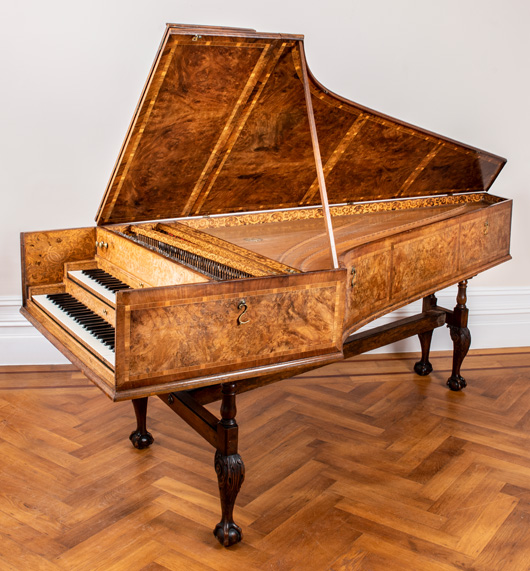Double-manual harpsichord by Jacob Kirckman, London, 1756
Compass: FF (excl. FF⋕) - f '''
Disposition: 2x8', 1x4' and lute.
Plectra material: bird quill.
Compass: FF (excl. FF⋕) - f '''
Disposition: 2x8', 1x4' and lute.
Plectra material: bird quill.

Alsatian by birth, Kirckman came to London and sought work with the German harpsichord builder, Hermann Tabel, at his workshop in London’s Piccadilly. It is not known under what circumstances or in which capacity Kirckman first came to work for Tabel, but it seems that when his master died in 1738 he had risen to the position of foreman. Kirckman took charge of the business on marrying Tabel’s widow in 1739, a move that seems to accord with the image of a man who was possessed of a shrewd business acumen. The firm’s instruments, which included various models of harpsichord, bentside spinet and later piano, were highly praised and are said to have commanded high prices. Indeed, on his death in 1792, Kirckman left a large and profitable estate, which included property in London and works of art by such masters as Rubens and Rembrandt. The case of this instrument is typical of Kirckman’s more opulent output: it is impressively veneered with burr walnut panels, banded with laburnum, and the keywell and interior are elaborately inlaid with holly marquetry. Late baroque and rococo decorative influences were strongly exploited in the visual arts in England during the 1740s and 50s and harpsichords of this period occasionally represent a high-point in the expression of the style, whilst at the same time appearing to recall an earlier era. This may be a reflection on the perceived ‘antiquity’ of the harpsichord as an established type with a celebrated heritage stretching back to the 15th, 16th and 17th centuries. This harpsichord was one of the firm’s full specification instruments. It boasts two manuals (keyboards) and three ‘choirs’ of strings: two at 8' (‘normal’) pitch and one at 4' (octave) pitch. Four registers of jacks (the action components containing the plectra that pluck the strings) can be engaged using handstops to sound these choirs independently or together; the fourth register is known as the lute stop and plucks the strings towards the end of their vibrating lengths creating a nasal sound that is considered reminiscent of the lute.
To visit a musical museum without music is like visiting an art gallery with your eyes closed
Richard Burnett